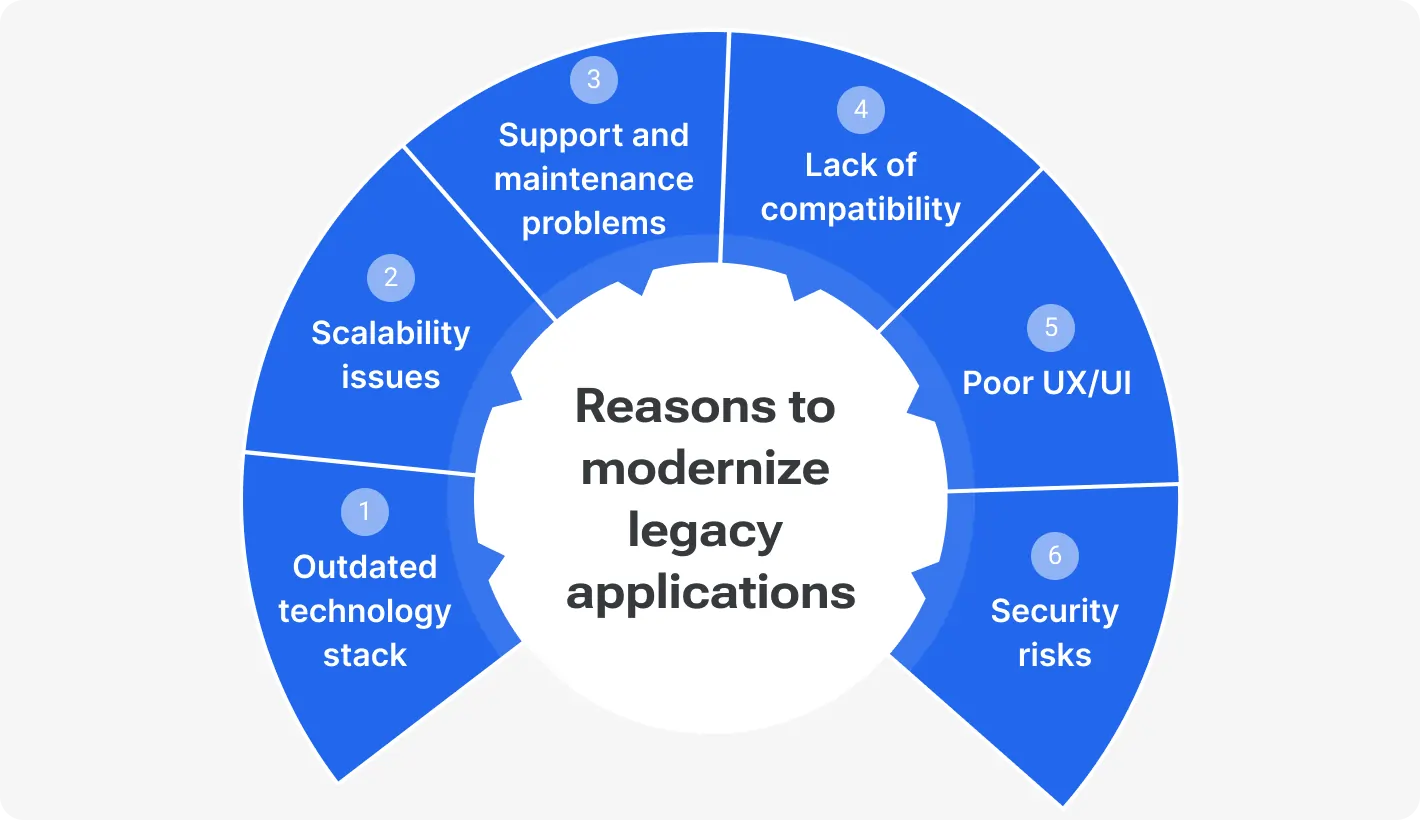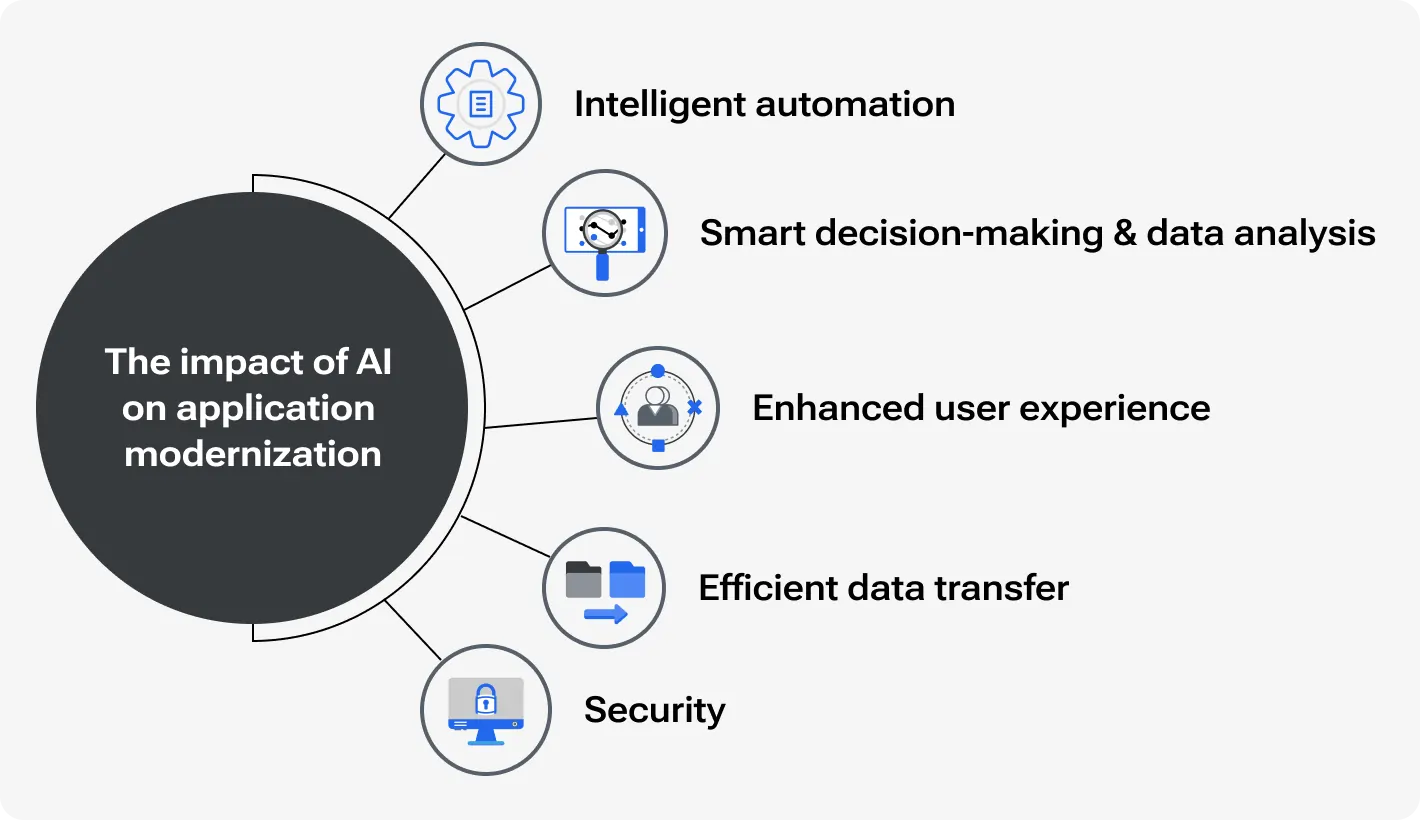Artificial intelligence is the current number one choice for automation, improvement, analysis, and troubleshooting. It provides a new way of solving existing operating issues. Naturally, AI becomes especially useful when it comes to legacy applications.
Legacy applications or systems is an umbrella term that refers to software that remains in active use: software applications, frameworks, and programming languages. However, some legacy systems continue to function effectively despite being outdated. Companies often maintain and utilize legacy systems essential to their daily operations and business requirements.
While some legacy apps may operate without any new functions or enhancements, for other legacy modernization is crucial. From a long-term perspective, it helps to stay competitive, reduce costs, enhance security, and ensure sustainability. This is where AI comes in handy. According to IBM's recent survey on the impact of generative AI on modernization, 89% of CEOs state that using AI in app modernization projects will level up growth by boosting existing products and services and building new capabilities.
Scale your business effortlessly with modernized IT solutions
So, let’s take a closer look at how AI can help in legacy application modernization.
Key Legacy Applications’ Issues
Although everything is clear from the name, legacy systems often have a certain set of characteristics that determine the essential problems that can be solved thanks to app modernization.

Obsolete technology stack. Typically, this software is built using outdated programming languages, frameworks, or modules that are no longer supported or have serious issues.
Scalability issues. Scalability is among the weakest points of legacy applications, as they struggle to keep up with increased workloads or adapt quickly to changing demands. They also lack flexibility for any further updates.
Support and maintenance problems. The main problems of supporting legacy apps are insufficient documentation, outdated hardware and software components that cannot be replaced without special skills.
Lack of compatibility. These applications tend to have limited compatibility with current systems, making it difficult, if at all possible, to integrate them with new technologies.
UX/UI. Their user interface (UI) lacks modern features and capabilities, making it look outdated compared to modern apps, leading to poor user experience and less user satisfaction.
Security Risks. These applications are more susceptible to security vulnerabilities and cyber threats caused by outdated security protocols and a lack of regular updates. They may also lack the built-in security features found in modern applications.
Despite the downfalls, outdated applications remain a weak point of the company because, as a rule, they contain a large amount of crucial data. Among key reasons for refusing to modernize applications promptly, are the high cost of work, complexity, and long term. Moreover, it'll impact all the company's processes, which can require additional efforts. Using artificial intelligence allows you to significantly reduce expenses and time, get a reliable assistant, and save all the necessary information, minimizing risks as much as possible.
Role of Artificial Intelligence in Modernization
The high cost and low efficiency of this process are responsible for the lack of permanent modifications to legacy applications and systems. The use of artificial intelligence can make almost all these obstacles disappear. At least more than 90% of company owners believe AI to be essential to modernization. Well, it is a game-changing tech, that offers innovative solutions to overcome challenges, unlock new capabilities, and drive digital transformation across industries.
Intelligent Automation
Automation based on artificial intelligence allows you to optimize and simplify outdated application processes. With the help of Natural language processing (NLP), organizations can automate repetitive and manual tasks. This helps reduce errors, improve efficiency, and free up resources for more valuable activities.
Smart Decision-Making and Data Analysis
Artificial intelligence provides you with the advantage of high-speed processing of a large amount of data, their systematization, analysis, and highlighting essentials according to an algorithm, thus, decision-makers obtain more substantiated and reliable arguments.
For example, AI can analyze user behavior to identify unused features or areas where an app is difficult to operate. Moreover, AI can analyze performance data to identify bottlenecks or areas where the app requires optimization.
Enhanced User Experience
Artificial intelligence-based tools such as chatbots, user interfaces that use natural language processing (NLP), and voice recognition technologies greatly increase the accessibility and interactivity of traditional applications. By creating immersive user interfaces, you enable smoother and more efficient interactions between users and their applications or services.
AI algorithms make a striking difference when it comes to personalization. They explore user preferences and behavior to develop customized interfaces and content. As a result, each user is tuned in to make them feel truly included.
Efficient Data Transfer
Application modernization work often involves moving data from legacy systems to cutting-edge platforms—that's where artificial intelligence comes in. Software integrated with artificial intelligence helps evaluate data structures while ensuring interoperability by cleaning and transforming data according to specific requirements; It also significantly reduces system downtime during the migration process. The result is a faster transition, which significantly reduces failures.
For example, IoT integration with legacy applications enables real-time monitoring and control of connected devices. Moreover, AI algorithms can come in handy with cloud migration to improve scalability, availability and cost-efficiency.
Security
It is enhanced through the use of AI-based security solutions that improve the protection of legacy systems against cyber threats and related risks. Machine learning algorithms are capable of detecting and remediating security breaches in real-time. This allows for identifying weaknesses at vulnerability levels, enforcing regulatory controls, protecting sensitive data, and maintaining trust.
Therefore, the use of artificial intelligence to update outdated applications can be truly revolutionary. You might need to adopt or develop a legacy AI modernization strategy from scratch to meet the challenges of legacy system re-engineering, cloud-based architecture migration, and the utilization of microservice processing and containerization. Application modernization driven by artificial intelligence enables the rapid development and deployment of modern applications, decreasing time-to-market and promoting continuous innovation, helping you to enter a new era of apps.
Successful Examples of AI-driven Legacy Application Modernization
Over the last few years, disruptive technologies have become an integral part of many industries, transforming them into efficient and reliable systems for both owners and customers. It is noted that the most changes are introduced today in the two large sectors of healthcare and finance. It is here that business owners direct the most funds to legacy modernization and implementation of innovative solutions using artificial intelligence. It is predicted that the global healthcare AI implementation would be worth almost 188 billion U.S. dollars by 2030.
Healthcare Industry
The first thing to understand is that healthcare has a complex and multi-level architecture that requires systemic changes and deep innovations, especially in terms of providing services to patients. The latest technologies are capable of automating, improving, and speeding up most of the internal processes of laboratories and hospitals, in addition to simplifying consultations and interaction between a doctor and a patient.
Today, for various reasons, the following types of systems require modernization: electronic health record (EHR) systems, hospital information systems (HIS), laboratory information systems (LIS), picture archiving and communication systems (PACS), radiology information systems (RIS), telemedicine systems, claims processing systems, patient engagement systems. Some industry leaders are already offering solutions based on legacy AI modernization.
Siemens Healthineers' Diagnostic Imaging Systems
Siemens Healthineers introduced AI-based solutions in response to the growing reliance on legacy diagnostic imaging technologies, which affected accuracy and efficiency. The company has supplemented its equipment with AI-powered modernized applications during the last few years. Acuson Maple Workhorse Ultrasound System is one of the latest achievements in this area. It is stated that AI-powered tools of the system have significantly improved everyday flow and allowed to obtain advanced image analysis capabilities and significantly increased the accuracy of diagnostic tests.
Thanks to modern tech the system offers 25 advanced features that enhance usability, improve image quality, and reduce exam time. For instance, a routine heart echo exam can be held for a bit more than five minutes instead of the usual ten due to AI-based automation of cardiac measurements and reduced keystrokes by up to 44%.
Mayo Clinic AI-Powered Projects
After successfully implementing an EHR system in its medical practice, Mayo Clinic, a leader in the field, continues to innovate. In late September 2023, they announced the start of testing the Microsoft 365 Copilot early access program to help physicians, clinical staff, and healthcare providers stay focused on patients while reducing admin workload.
Copilot is an AI technology that seamlessly integrates Large Language Models (LLMs) with calendars, emails, chats, documents, and more to improve productivity. For example, it allows to automate the filling of forms and saves valuable time helping patients. Although the system is still being tested at the Mayo Clinic, integration with other fields showed that 88% of users said they were more productive with Capilot.
Moreover, the Mayo Clinic was able to improve a screening tool used in cardiovascular medicine with an AI-based solution. While artificial intelligence is widely used to detect heart disease, treat strokes more quickly, and improve diagnostic radiology capabilities, the Mayo Clinic focused on a specific patient condition: left ventricular dysfunction. The AI-powered screening tool identified people at risk for the disease 93% of the time. With this in mind, mammography is accurate in 85% of cases.
Financial Sector
The slow-to-change financial sector bets on the reliability of its services, despite the obvious downfalls of its legacy systems. Most programs are built on outdated technologies, so they currently lack the flexibility and scalability of modern applications, require constant expensive maintenance, and can no longer meet the ever-growing customer demand. In addition, companies have to balance between innovation and risks protecting sensitive financial data.
AI-based assistance helps to go through major challenges and obtain the required result: increase compatibility and agility of the app, enhance security and protection algorithms (authentification, fraud detection), improve usability (by adding new options, focusing on trending availability), transit data to new cost-efficient storage, etc.
JPMorgan Chase & Co
JPMorgan has invested a lot in AI-based technologies for a variety of applications. Such as fraud detection, risk management, trading algorithms and customer service. The company uses AI to modernize legacy systems and improve operational efficiency in its business lines.
J.P. Morgan integrated AI-based LLMs for payment validation screening almost two years ago. It speeds up processing, reducing false positives and improving queue management. The result has been a reduction in fraud and a better customer experience, with a 15-20% reduction in rejection rates. J. P. Morgan also uses artificial intelligence to automatically show information to clients, for example, cash flow analysis.
Citigroup
Citigroup started to integrate AI into its daily operations back in 2019, leveraging AI algorithms for customer compliance service to identify weaknesses and bottlenecks, which in the long-term perspective led to improved customer service, higher satisfaction rates, and the ability to provide them with personalized experience.
Over the years, Citigroup has supported investment in artificial intelligence and explored its potential for further use in banking. The bank is studying ways to implement artificial intelligence for document analysis. To free up employees' time to work with customers instead of numbers, Citigroup implements AI algorithms that automate the analysis of earnings and other public documents, which allows to reduce the time for preparing reports.
Citigroup integrates LLMs to analyze laws and regulations in the countries it manages to ensure it complies with these rules. Constant monitoring in this area with the help of AI also significantly reduces expenses.
Currently, Citigroup is considering the use of artificial intelligence for legacy modernization, as this will significantly reduce time and budget expenses, and solve the possible challenges of transitioning from the outdated COBOL language to the more modern Java.
AI-powered legacy modernization helps to solve particular industry or facility challenges from automation to reduction of expenses, which leads to better performance and higher profits.
Best Practices of Implementing AI in Legacy Application Modernization
Considering the number of problems associated with legacy applications, most companies choose between using technology without updating or creating a completely new system that should replace the existing one. The main obstacle to modernization is the high cost of updating and implementing new technologies, in most cases this is not even possible, however, with generative artificial intelligence these problems can be solved.
Code Review And Generation
The problem with the outdated code is the difficulty of working with it because it involves a deep analysis of a voluminous database.
Entrust this work to AI, which can identify outdated code, and offer the best option for updating it, from translating it into another programming language to deriving functionality into a microservice. You will also receive a thorough analysis of the database, its reliability and methods of updating, for example, transit to the latest technologies. In addition, generative artificial intelligence can automatically correct errors, monitor the need to update libraries and frameworks and provide seamless integration with them.
Technical Debt Management
Over the years of existence, legacy apps accumulate not only technical debt but also interest, which significantly complicates code optimization in the future: the more the application is used, the more updates it has, and the more technical debt it eventually accumulates.
AI-powered assistance makes refactoring much easier, helping to identify code duplicating, extra memory, or other resource usage. To level up app performance AI can offer code quality enhancements, unit test case generation, or in some cases refactoring parts of monolithic code into composable.
Architecture Updates
Most legacy applications cannot compete with modern ones due to complex, unclear, or confusing architecture that requires additional efforts for the latest integrations and maintenance.
AI-powered analyzing tools can explore existing architecture, identify pitfalls and weaknesses, and suggest possible solutions. They can include moving to reliable and cost-efficient cloud-based storage, transit to microservices, or replacing outdated components. Depending on the algorithm or tool used, you can get recommendations for creating a hybrid architecture, containerization, or disaster recovery.
Scalability Solutions
Poor scalability and performance are some of the core problems of legacy apps that can be met with in-depth AI analyzing algorithms.
Generative AI identifies bottlenecks and offers a proper solution to handle high workloads. There can be new configurations for load balancers and algorithms to optimize traffic distribution. Depending on the possibility of horizontal or vertical scaling, artificial intelligence offers strategies and scenarios that are suitable for each specific case, for example, content delivery network with caching mechanisms, or asynchronous data processing.
Trending UX/UI
It is quite logical that outdated applications are not user-friendly at modern standards. The use of artificial intelligence allows you to quickly and cost-effectively solve this issue.
AI can generate a new design or a CSS code to prove the app with mobile compatibility and improve usability. It also allows to make the app more appealing to customers and even available for people with disabilities, generating a keyboard navigation for them.
It is important to note that the application of AI elements such as algorithms is only the beginning of this journey towards systematic improvements based on AI transformations–who knows what avenues of research may open up in the future! Last but not least, always up-to-date on rapid technological breakthroughs, as well as expert advice on installing or revising capabilities focused on improving legacy apps.
Pitfalls to Avoid in App Modernization
App modernization can be difficult and tricky. This is usually due to the number of problems that need to be solved during the upgrade, which is layered with years of using outdated applications and technologies. Of course, each case of modernization is individual and it is impossible to accurately predict all the bottlenecks and weaknesses that a company may face during the upgrade, but several common mistakes can be avoided in the modernization process.
Poor Preparation
Always start with planning and clearly defining the goals and the result of the modernization. It will be much easier for you to synchronize your actions with the executors and monitor the progress if you are aware of exactly what you want to get at the end.
Thoroughly explore the structure and materials that need updating in order not to lose important information and data. You will waste much more time searching for an error or the necessary information than on preparation. Don't underestimate the complexity of the work ahead of you, it will lead you to a mistake with the choice of performers, the allocation of funds, and identifying deadlines.
Incorrect choices
Do not rely only on technology, you can choose the most effective option on the market, but this tool may not be very suitable for your tasks. Develop a strategy taking into account the characteristics of your legacy system and the necessary changes, use the help of professionals, or have reliable consultants at hand.
If your main changes are expected in the user interface and user experience, try to study the trends of your industry in advance and also conduct a survey or at least find out the needs of your direct customers. This will help you get as close as possible to the desired result and save money on regular interface updates.
Inconsistency of Team And Goals
Everyone from the top management to the business and technical team should be involved in the modernization process, they should all be synchronized and stay on the same page to avoid delays and misunderstandings regarding what and how will happen in the modernization process.
Often the problem is that a complex and long-term modernization process can hinder the company's promotion on the market and will require the optimization of future goals. It is necessary to find a balance between business goals and technical modernization. Prepare a detailed legacy modernization plan that involves mitigating risks and an action plan in case of emergencies.
Challenges in Implementing AI in Legacy Application Modernization
Implementing IT legacy modernization by applying AI algorithms allows you to meet general bottlenecks on the way to a more efficient app, however, you can face some specific challenges.

Your first obstacle might be regulatory and compliance issues. This is especially true for industries with clear rules that are governed by an infinite number of laws and standards such as healthcare and finance. Before implementing AI-driven solutions companies must identify all possible concerns.
Another significant obstacle can be the excessive costs and terms of modernization with the help of artificial intelligence. Although today this method is recognized as most effective, including due to its cost, the process itself may still require the allocation of significant budgets.
The use of artificial intelligence to modernize applications is called to increase the security and reliability of data and the application as a whole, however, it can also become a weak point during data integration or migration, and additional security protocols or procedures need to be implemented.
Moreover, the use of third-party applications, as well as their providers, can make you dependent on them and significantly reduce the flexibility and scalability of potential changes and updates of programs.
AI in Legacy Application Modernization Future Trends and Predictions
Do we need to say additionally that great hopes are placed on artificial intelligence in this and next years as well?
“We've been on application modernization [for at least 10 years], because organizations had to address this," he said. "But now, generative AI, and AI in general, has put a different lens on application modernization, a further horizon and a bigger capability that you're able to apply to it…”, said Erik Duffield, CEO at Hakkoda.
5 trends in legacy modernization
According to Hakkoda research, more than 90% of organizations surveyed said they need to modernize their data stack in 2024. The report says the move will help them "harness the power of GenAI."
Ryan Yackel, CMO at IBM Databand.ai, in the DATAcated Trends & Predictions report claims: “Embedding AI in the fabric to boost productivity, reduce cost, and shorten time for data teams to extract value will provide the context for AI initiatives, leveraging semantic automation to bring a business frame of reference.”
The key areas of AI-based modernization of legacy applications are still the automation of internal processes, improving user experience and interface, and strengthening security and analytics tools. Artificial intelligence combined with AutoML can be a powerful tool for tasks such as data pre-processing, feature development, modeling, post-processing, and analysis of the results. It will allow the processing of a large amount of data, make reasonable conclusions, and contribute to improved decision-making at all levels of modernization.
The NLP implementation should greatly boost the user experience due to the ability to understand human behavior, and preferences to shape and build a completely new user experience and journey. According to Jeff Catlin, EVP of AI Products at InMoment, “Powerful NLP that can break down unstructured and semi-structured content by speaker, region or problem area will take LLM's diagnostic capabilities to the next level.”
With the rapid development of AI technology, it is very difficult to set specific terms or forecasts regarding the appearance of the latest algorithms or methods of their use, however, it will be a must-have for all who want to modernize legacy fast and cost-effectively.
Wrapping it Up
Deep integration of artificial intelligence in the legacy app modernization is only a matter of time. It is already widely used for automation and speeding up internal processes, reducing bureaucracy and cutting costs for maintenance and updates. AI capabilities allow you to solve core issues, make applications modern and scalable, improve performance, and provide companies with a competitive advantage.
Generative AI is an essential tool for the digitalization and modernization of outdated applications. It is applied to analyze and explore different components of the program to get reliable advice on better ways of renovation. It is a great assistant that provides you with practical solutions considering the specifics of your app.
Despite the possible issues and pitfalls of applying AI, modernization is a necessary process that allows companies to remain competitive and break ahead in their industry. No matter how controversial innovative solutions are, they need to be implemented as soon as possible as most forecasts confirm the rapid growth of the use of new technologies shortly.
Transform your legacy systems to boost efficiency and innovation







